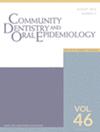The objectives were to: (i) assess the accuracy of dental data for adults obtained from the Swedish Quality Register on Caries and Periodontitis (SKaPa); (ii) explore whether Latent Class Analysis (LCA) can identify groups of people based on caries data; and (iii) characterise the dental, medical and behavioural characteristics of people in the LCA-derived classes.
Caries data from the SKaPa register were compared with clinical data collected by five experienced dentists in a nested subgroup of the Malmö Offspring Study (MOS), namely the Malmö Offspring Dental Study (MODS) (n = 724) for validation. Dental data from SKaPa were then used to classify 61 984 adult participants of the Västerbotten Intervention Programme (VIP) into five classes using LCA and DMFS-based quintile ranking, respectively. Dental status (including caries progression over 5 years), medical, anthropometric and behavioural characteristics were compared between the groups. Analyses were replicated in 2767 adults in the MOS.
DMFS-scores and number of teeth recorded within −2 to +2 years showed excellent agreement between the SKaPa and reference data with intra-class correlations > 0.90. The five LCA classes differed in mean DMFS from 10.0 to 94.4. There were strong associations between LCA class and health, and health and behavioural measures respectively, including some associations that were not detected using DMFS-ranked quintile groups. LCA class was associated with incremental change in DMFS, DFS, and number of teeth. The results in the MOS cohort were consistent with the results in the VIP cohort.
Dental data for adults from the SKaPa registry were considered accurate within 2 years of recording. The LCA approach can classify participants into caries subtypes based on dental charting. These groups differ in health and behavioural characteristics and future caries increment. The LCA approach may capture some information that is missing from DMFS-ranked quintile groups, but is also heavily influenced by total DMFS, meaning that applying LCA in cumulative, highly age-determined diseases, such as caries, is a challenge.



